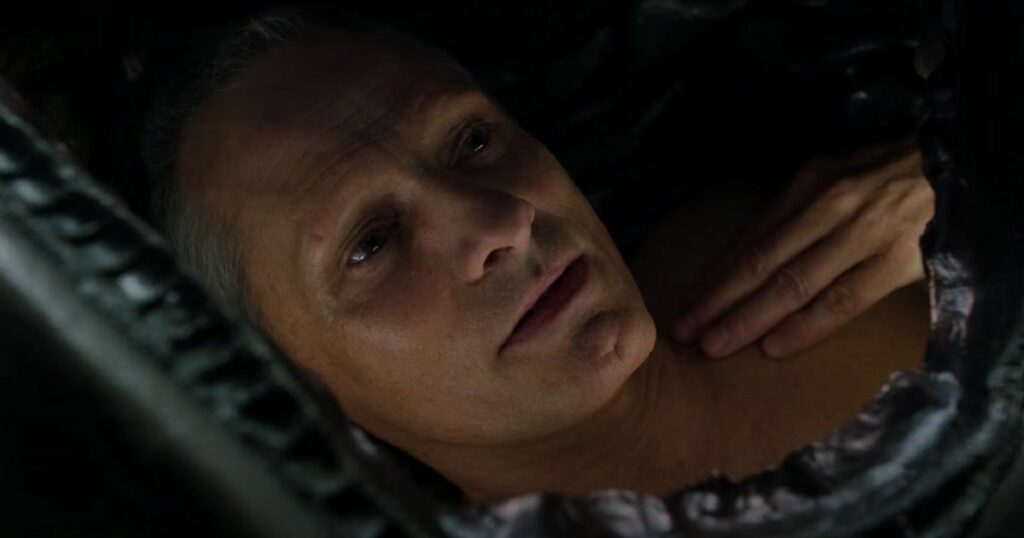David Cronenberg pretty much wrote the book on body horror, the subsection of scary movies that put a disturbing focus on the gross and painful transformations and punishments that the body can endure. The Canadian filmmaker has shocked the censors and audiences alike since the 70s with his boundary-pushing explorations of technology, violence and sensuality. Jaw-dropping special effects and makeup don’t hurt either.
Cronenberg’s films have always dealt with the physical, often in the most intimate and extreme ways. This has held true even when the director seemingly left the world of sci-fi horror behind with 1999’s eXistenZ. The past two decades of Cronenberg have been thrillers and dramas (no less intense than his earlier work, mind you) but something in the dystopian air of the 2020s has brought him back to his roots in more ways than one.
Crimes of the Future is a triumphant return to original thought-provoking sci-fi for the filmmaker. This is a much older Cronenberg now with a lot more than usual on his mind even for him, which turns this into what is perhaps his most poignant exploration of themes and ideas that have been with him throughout his career. While perhaps not as explosively or excessively grotesque as certain viewers may be pining for, rest assured that he certainly still hasn’t lost any of his edge.

Courtesy of Neon
The film shares the same name as his 1970 sci-fi story of a world devoid of fertile women, though the two bear little resemblance if any. 2022’s Crimes of the Future takes place in a world where advancements in biotechnology as well as mutations in human biology itself have all but eliminated physical pain and infectious disease. Even so, this is no utopia. Climate change and ecological disasters have thoroughly ravaged the planet and as one character puts it, pain had a purpose - it’s the body’s warning sign.
Saul Tenser (Viggo Mortensen) is a performance artist alongside his partner Caprice (Léa Seydoux). Tenser has a unique disorder that causes his body to constantly develop new organs, which Caprice surgically removes before a live audience. The shocking and provocative act is one that the couple take more seriously than anything else; Crimes of the Future is, above all else, a film about artists and art itself, its role in society and its transformative power.
When the two are brought into the National Organ Registry, a government branch that catalogs all newly evolved organs, the investigators in charge of the office, Wippet (Don McKellar) and Timlin (Kristen Stewart) are immediately infatuated with the artists’ perspectives. Timlin especially is captivated by the sexual nature of the act and takes a special interest in Tenser, leading to the aging but no less ambitious artist to suddenly become swept up in a plot of government coverups and radical revolutions.

Courtesy of Neon
While that may initially seem very exciting and in line with Cronenberg classics like 1983’s Videodrome, Crimes of the Future is instead very dialogue-heavy, yet proves to be one of his most engaging and deeply ponderous scripts he’s ever put to screen. The setting feels like one his more fully realized worlds, one imbued with an almost surrealist, satirical wit and as always, an eerily prescient view of humanity’s not-so-distant future.
Deep conversations about art and meaning blend with a story about evolution and humanity, while at the same time the film can be viewed as an autobiographical piece about an aging artist going through physical and mental changes. Tenser speaks a lot about suffering for his art and never knowing when it will come, or in this later stage in his life, if it still will at all. Further parallels to the filmmaker’s life, such as the desire for integrity behind art like Tenser and Cronenberg’s, can be found throughout the film.
Crimes of the Future’s production design is as precise and macabre as one expects from a Cronenberg picture. Particularly memorable are the intricate contraptions that Tenser uses both at home (like his bed or his chair) and in his performances with Caprice, where they use a top of the line mechanical autopsy table. Naturally, it looks just like a sarcophagus.

Courtesy of Neon
Cronenberg’s latest operates in a strange realm that feels both bleak and beautiful, horrific and cathartic. As always, it’s an astute look at humanity’s constantly shifting dynamic between our bodies and our technology, and its profound effects on our minds. A tale of governments regulating bodies, finding meaning in the desolation of our natural world, and having the courage to evolve beyond societal limitations, Crimes of the Future is quietly bold, consistently sharp with its wit and graphic content, and as personal as a Cronenberg film has ever been.
‘Crimes of the Future’ is now playing in theaters.




